Étiquette : Bande/Tape

New York Philharmonic Bruno Walter
Carnegie Hall – 24 Janvier 1954
Source: Bande/Tape 19 cm/s / 7.5 ips
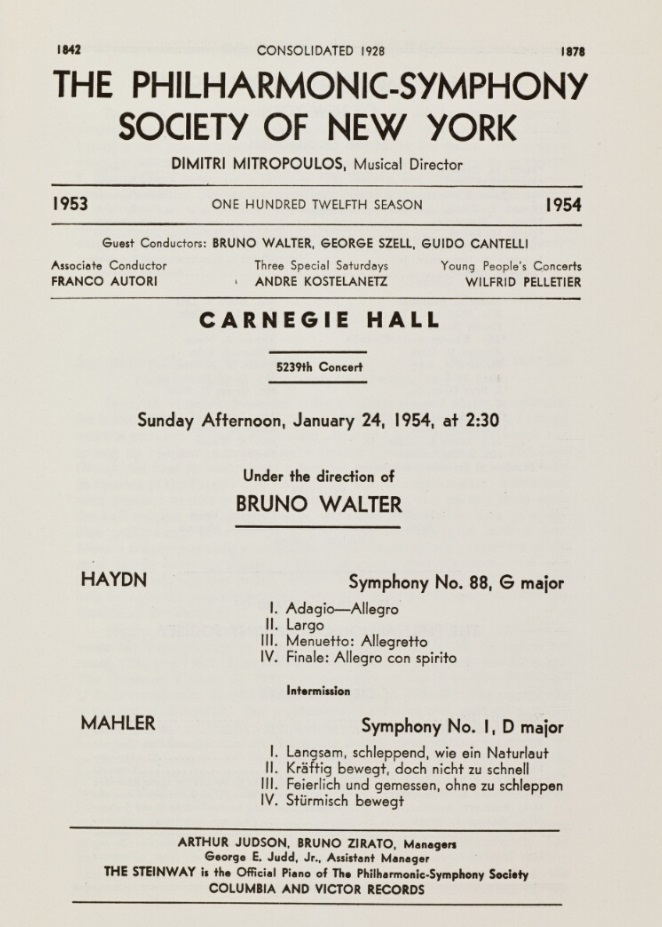
Bruno Walter a dirigé plusieurs fois cette symphonie avec le NYPO, et ce dès 1924 (les 28 et 29 février). Il la dirigea de nouveau en octobre 1933 (les 12, 13, 14, et 15), en octobre 1942 (les 22, 23, 24 et 25), en février 1950 (les 9, 10 et 12) et enfin une seule et unique fois en 1954, pour le concert radiodiffusé du dimanche 24 janvier depuis Carnegie Hall, suivi le lendemain par l’enregistrement pour Columbia dans cette même salle (plutôt que dans l’ habituel « Columbia 30th Street Studio »). Le concert public est plus vivant que sa contrepartie pour le disque. On remarque, à l’écoute de l’enregistrement du concert, une certaine sécheresse de l’acoustique de Carnegie Hall, que l’on ne perçoit pas dans la salle vide où le disque a été capté.
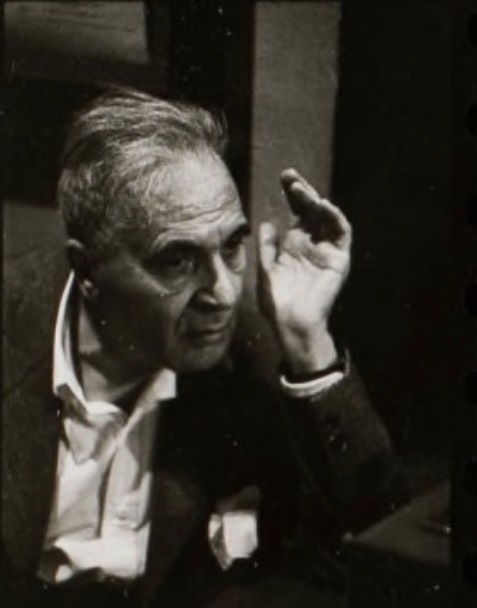
Bruno Walter conducted several times this symphony with the NYPO, as early as 1924 (February 28 and 29). He conducted it again in October 1933 (12, 13, 14, and 15), in October 1942 (22, 23, 24 and 25), in February 1950 (9, 10 and 12) and only once and for the last time in 1954, for the Sunday broadcast Concert of January 24 from Carnegie Hall, followed on the next day by the recording for Columbia in the same venue (rather than the usual « Columbia 30th Street Studio »). The live performance is more lively than its disc countertpart. When listening to the broadcast concert, one notes some dryness in the acoustics of Carnegie Hall, not to be found in the empty hall where the disc has been recorded.
Les liens de téléchargement sont dans le premier commentaire. The download links are in the first comment.
Brahms Lieder und Gesänge Op.32 n° 1-6 & 9 Hertha Klust piano
Berlin 25 mai 1955 – Prod: Fritz Ganss Eng: Horst Lindner
Mahler Lieder eines fahrenden Gesellen – Philharmonia Orchestra Wilhelm Furtwängler – London Kingsway Hall 24 & 25 juin 1952
Prod: Lawrence Collingwood Eng: Douglas Larter
Bande HMV 19cm/s 2 pistes HTB 409
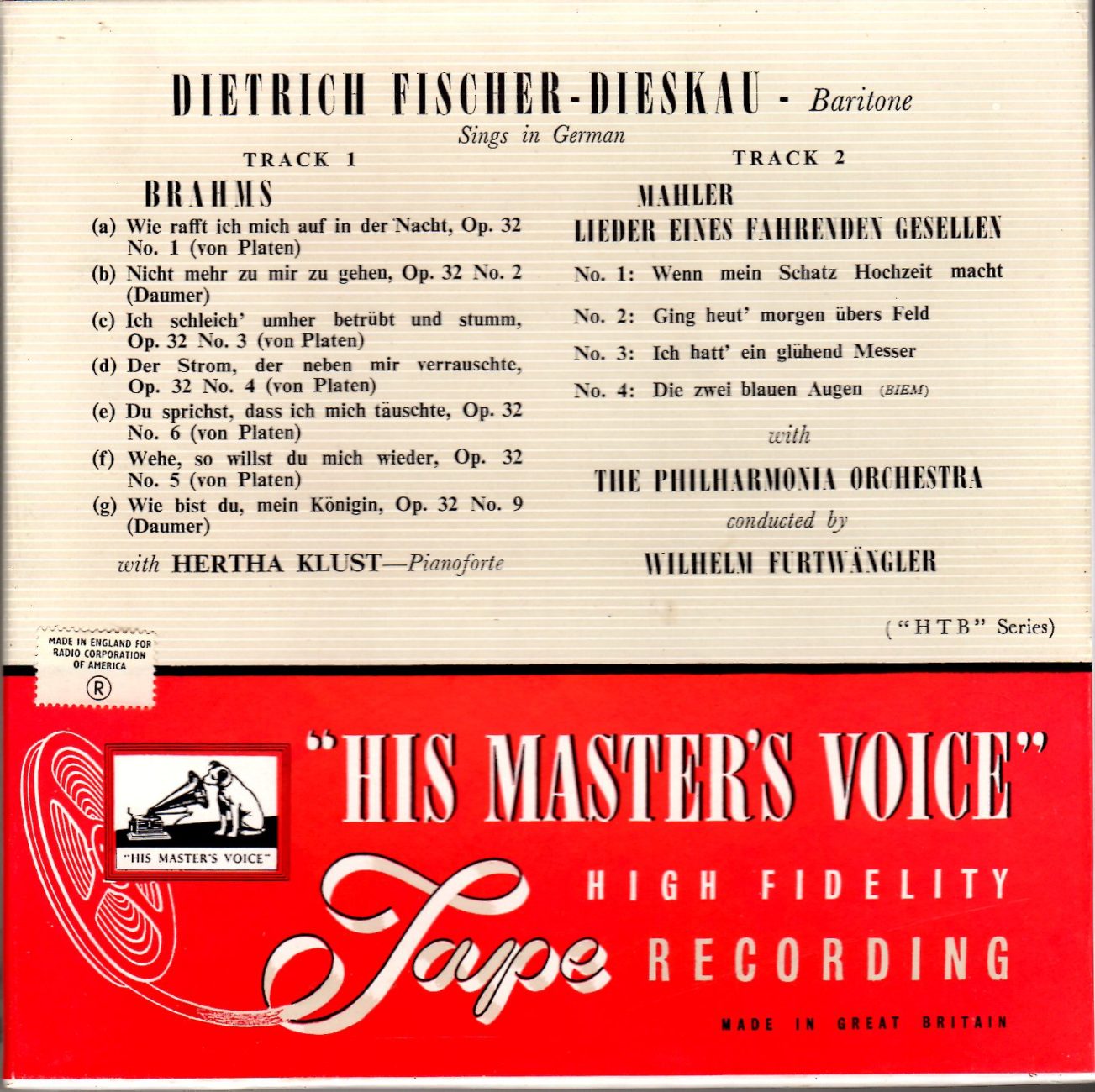
En 1956, HMV a publié ces enregistrements en microsillon (ALP 1270), mais aussi sous forme de bande magnétique HTB 409. Le couplage de ces deux œuvres est inhabituel, et ce d’autant plus que Fischer-Dieskau a enregistré en juin 1955 les Kindertotenlieder de Mahler avec le BPO sous la direction de Rudolf Kempe. Essayons d’en décrypter les raisons:
Les Lieder eines fahrenden Gesellen ont été enregistrés par Fischer-Dieskau et Furtwängler les 24 et 25 juin 1952 en profitant du temps d’enregistrement disponible après les séances consacrées à l’intégrale de Tristan und Isolde de Wagner.
Le 29 novembre 1953, Furtwängler écrit à Walter Legge en évoquant l’enregistrement du Monologue d’Amfortas en projet avec Fischer-Dieskau et le Philharmonia lors de sa venue à Londres en mars 1954: « J’imagine que les Lieder eines fahrenden Gesellen enregistrés avec Fischer-Dieskau n’ont toujours pas été publiés. Comme je fais dans les prochains jours les Kindertotenlieder avec Fischer-Dieskau à Berlin, ce serait semble-t-il une bonne idée de les enregistrer à la place du Monologue d’Amfortas si on dispose d’assez de temps ». Le 3 décembre, Legge confirme ce changement. De plus, entre les deux concerts de Furtwängler prévus avec le Philharmonia au Royal Festival Hall les 5 et 12 mars 1954, un étonnant Récital de Lieder de Schumann avait été programmé le 7 mars dans cette même salle avec Fischer-Dieskau et Schwarzkopf, Furtwängler étant au piano. Legge propose le programme suivant: Dichterliebe, Frauenliebe und Leben et 15 Duos.
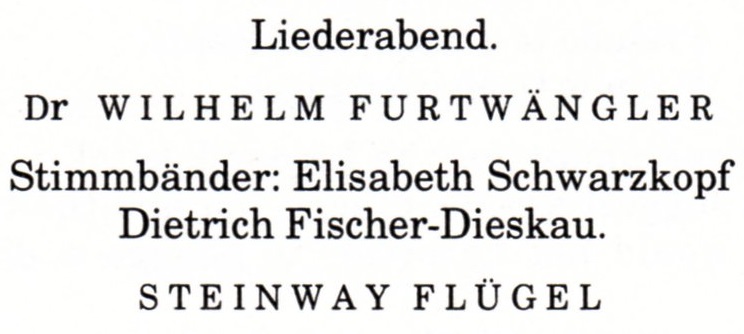
Le 12 janvier 1954, Furtwängler écrit à Legge depuis le sanatorium d’Ebersteinburg (Baden-Baden) où il doit séjourner pour se remettre des effets de ses traitements aux antibiotiques américains qu’il avait pris le mois précédent. Il a du annuler une tournée avec le BPO et une autre (au Portugal) avec le WPO, ainsi qu’une série d’autres concerts. Il annonce en outre qu’il ne pourra assurer à Londres que le concert du 12 mars. Il demande donc d’annuler le concert du 5 mars et le Récital du 7 mars. Le 18 janvier, Legge lui répond en exprimant ses regrets. Le 2 février, Furtwängler lui confirme qu’il ne dirigera que le concert du 12 mars et en confirme le programme. Le 7 février, Furtwängler écrit à Legge pour lui faire savoir que ses médecins l’autorisent finalement à reprendre ses activités le 1er mars et qu’il a programmé une série d’enregistrements avec le WPO (N.B. en fait du 28 février au 8 mars). Il n’est plus question d’enregistrer les Kindertotenlieder. Il n’en sera également pas fait état dans les échanges ultérieurs entre le chef et Legge.
Quant à Fischer-Dieskau, il recherchera activement, mais en vain, un enregistrement des Kindertotenlieder provenant des concerts berlinois de décembre 1953.
Dans ses mémoires, il laisse entendre qu’à l’époque il n’est pas satisfait de l’enregistrement qu’il en a fait avec Rudolf Kempe et le BPO en raison du manque d’entente entre l’orchestre et le chef. Ce sont probablement les raisons du choix du couplage Brahms/Mahler, grâce auquel la subtilité du piano d’Hertha Klust (1907-1970), que d’ailleurs Furtwängler appréciait beaucoup, mais dont la carrière fut semble-t-il abrégée par des problèmes auditifs, répondait à celle de la direction de Furtwängler.

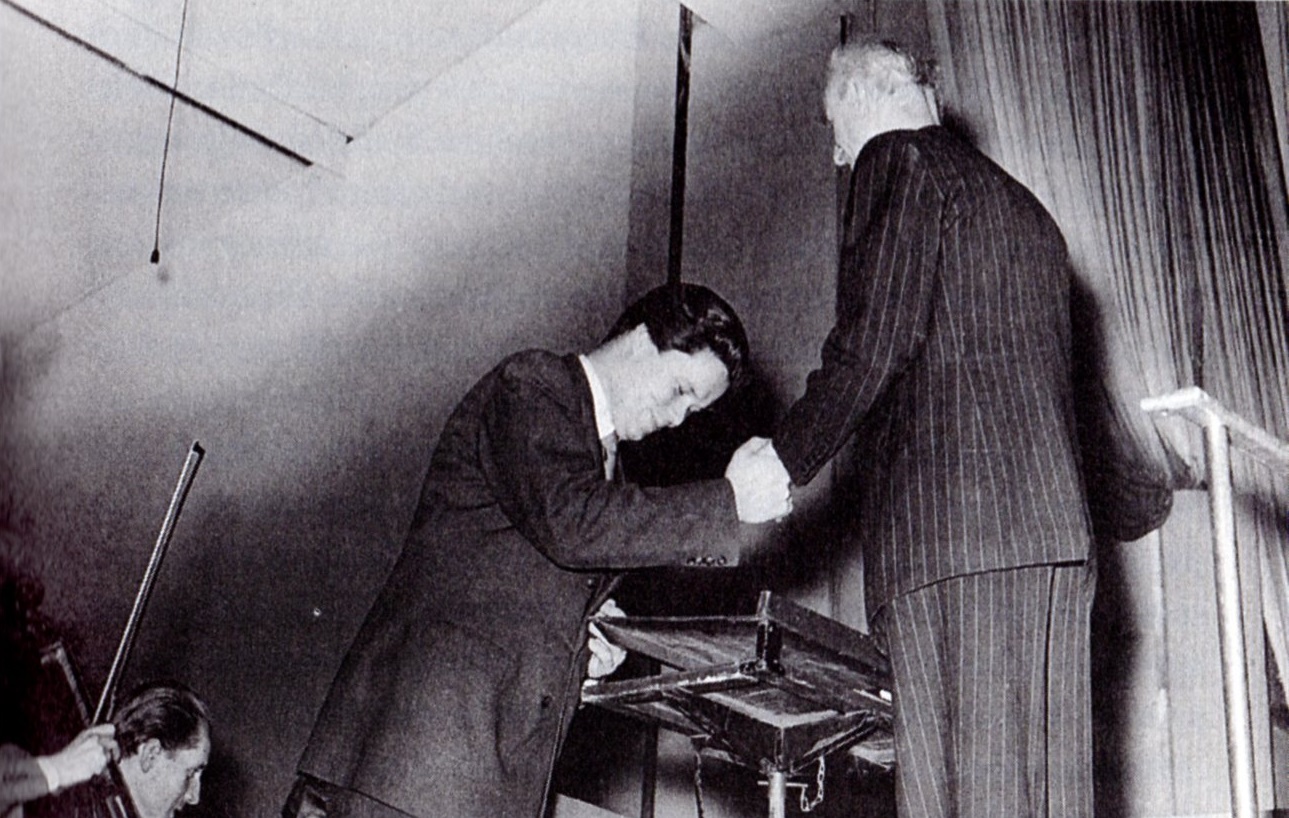
Dietrich Fischer-Dieskau & Wilhelm Furtwängler – Titania Palast Décembre 1953
______________
In 1956, HMV published these recordings as a LP (ALP 1270), but also on a reel-to-reel magnetic tape HTB 409. The coupling of these two works is unusual, al the more so, since Fischer-Dieskau recorded in June 1955 Mahler’s Kindertotenlieder with the BPO conducted by Rudolf Kempe. Let’s attempt an explanation:
The Lieder eines fahrenden Gesellen were recorded by Fischer-Dieskau and Furtwängler on June 24 and 25, 1952 during available recording time further to the sessions devoted to the complete recording of Wagner’s Tristan und Isolde.
On November 29, 1953, Furtwängler writes to Walter Legge and mentions the project recording of the Amfortasmonolog with Fischer-Dieskau and the Philharmonia during his stay in London in March 1954: « I gather that the Lieder eines fahrenden Gesellen with Fischer-Dieskau, which we recorded, have still not been released. As I am doing the Kindertotenlieder with Fischer-Dieskau in Berlin in the next few days, it would seem to be a good idea to record this as well – instead of the Amfortasmonolog – if there is time ». On December 3, Legge confirms the change. Moreover, between both Furtwängler’s concerts arranged with the Philharmonia at the Royal Festival Hall on March 5 and 12, 1954, an astonishing Recital of Lieder by Schumann had been scheduled on March 7 in the same venue with Fischer-Dieskau and Schwarzkopf, Furtwängler being the pianist. Legge suggests the following program: Dichterliebe, Frauenliebe und Leben and 15 Duets.

On January 12, 1954, Furtwängler writes to Legge from the Ebersteinburg sanatorium (Baden-Baden) were he has to stay to undergo a course of treatment which became necessary as a consequence of American antibiotics which were given to him the previous month. He had to cancel a tour with the BPO and another one (in Portugal) with the WPO, as well as a series of other concerts. He also mentions he will be able to conduct only the second London concert on March 12. As a consequence, he requests the cancellation of the March 5 concert as well as of the Recital of March 7. On January 18, Legge answers and expresses his regrets. On February 2, Furtwängler confirms he will conduct only the March 12 concert and also confirms the program. On February 7, Furtwängler writes to Legge to inform him that his doctors can discharge him as early as March 1st and that he has arranged with the WPO to do some recordings during that period (N.B. in fact between February 28 and March 8). It is no longer contemplated to record the Kindertotenlieder. Nor will this recording be further discussed in the next letters between the conductor and Legge.
As to Fischer-Dieskau, his active searches to find a recording of the Kindertotenlieder from the December 1953 Berlin concerts remained fruitless.
In his memoirs, the singer suggests that he was then not satisfied with the recording of this work he made with Rudolf Kempe and the BPO, because of the lack of understanding between the orchestra and the conductor. These are probably the reasons for the choice of the Brahms/Mahler coupling, thanks to which the subtility of the piano of Hertha Klust (1907-1970), whom by the way Furtwängler liked very much, but whose career was most probably shortened by hearing problems, mirrored that of Furtwängler’s conducting.
Les liens de téléchargement sont dans le premier commentaire. The download links are in the first comment.
Franz Schubert Symphonie n°6 D.589: 22-25 février 1965
Prod: Ray Minshull Eng: Gordon Parry
(Bande 19cm/s 4 pistes London LCL 80180)
Symphonie n°8 D.759: 13-17 mars 1959
Prod: Erik Smith Eng: James Brown
(Bande 19cm/s 4 pistes London LCL 80038)
Wien Sofiensaal
___________
Voici enfin le Volume III avec les symphonies n°6 & 8 « Inachevée » de Franz Schubert enregistrées à la Sofiensaal de Vienne par les Wiener Philharmoniker sous la direction de Karl Münchinger. Pour cette dernière œuvre, Münchinger pousse très loin les contrastes dynamiques, à l’instar de Wilhelm Furtwängler. Ceci rappelle que, si Münchinger a étudié à Leipzig la direction d’orchestre avec Hermann Abendroth, son modèle était Wilhelm Furtwängler. Il n’est donc guère étonnant qu’il y ait des similitudes entre son interprétation et celle de Furtwängler.
To end with, here is Volume III with Franz Schubert’s Symphonies n°6 & 8 « Unfinished » recorded in Vienna at the Sofiensaal by the Wiener Philharmoniker conducted by Karl Münchinger. In the latter work, it is clear that Münchinger pushes very far the contrasts in dynamics, in the style of Wilhelm Furtwängler. This reminds us that, although Münchinger studied conducting in Leipzig with Hermann Abendroth, his model was Wilhelm Furtwängler. Little wonder then that there are similarities between his performance and Furtwängler’s.
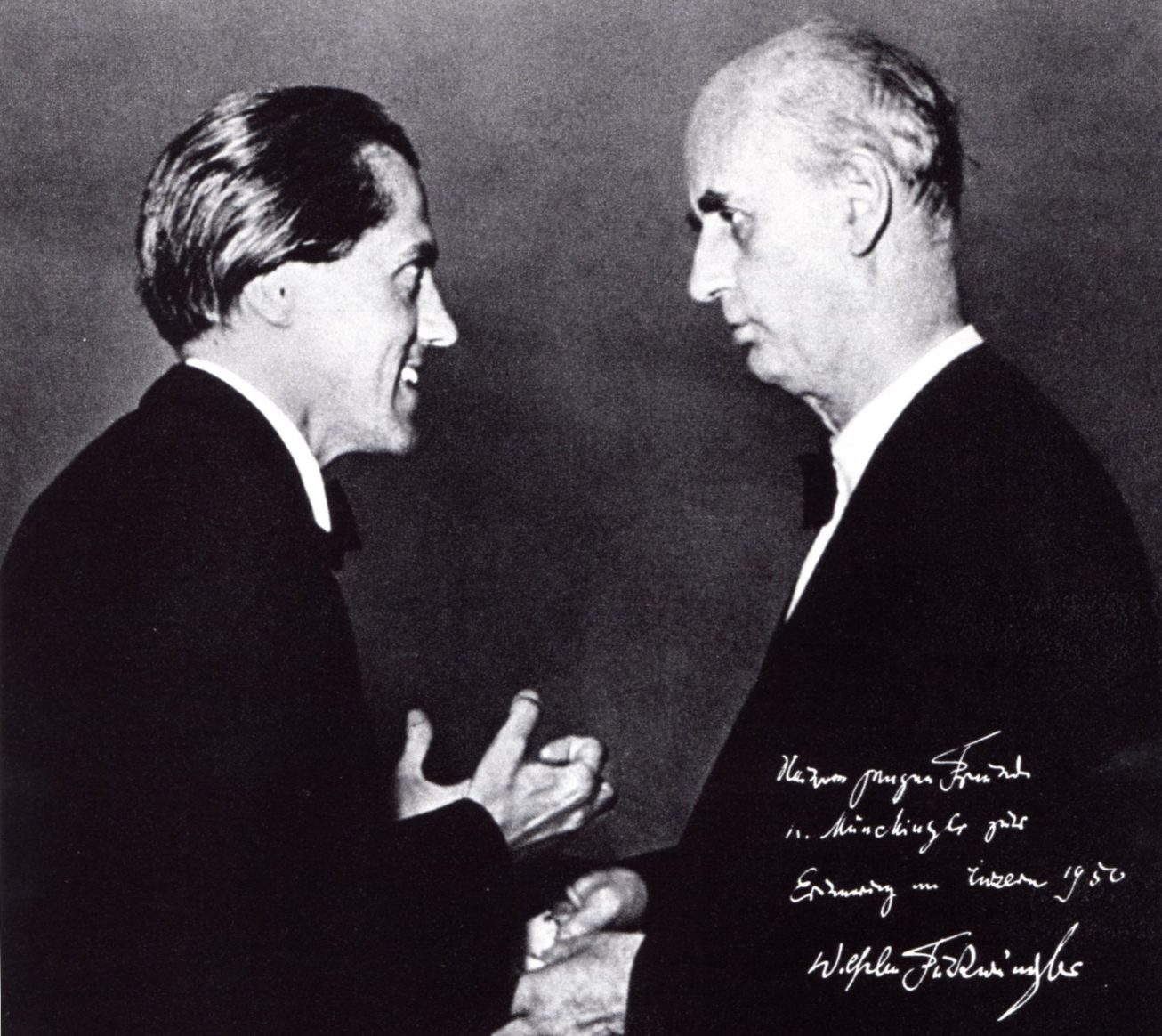
Karl Münchinger & Wilhelm Furtwängler (Luzern 1950)
___________
Les liens de téléchargement sont dans le premier commentaire. The download links are in the first comment.
Symphonie n°4 D.417 – 23 & 24 octobre 1963
Symphonie n°5 D.485 – 21 & 22 octobre 1963
Prod: Ray Minshull Eng: Gordon Parry
(Bande 19cm/s 4 pistes London LCL 80143)
Wien Sofiensaal
Voici le Volume II avec les symphonies n°4 & 5 de Franz Schubert enregistrées en Octobre 1963 à la Sofiensaal de Vienne par les Wiener Philharmoniker sous la direction de Karl Münchinger.
Here is Volume II with Franz Schubert’s Symphonies n°4 & 5 recorded in October 1963 in Vienna at the Sofiensaal by the Wiener Philharmoniker conducted by Karl Münchinger.

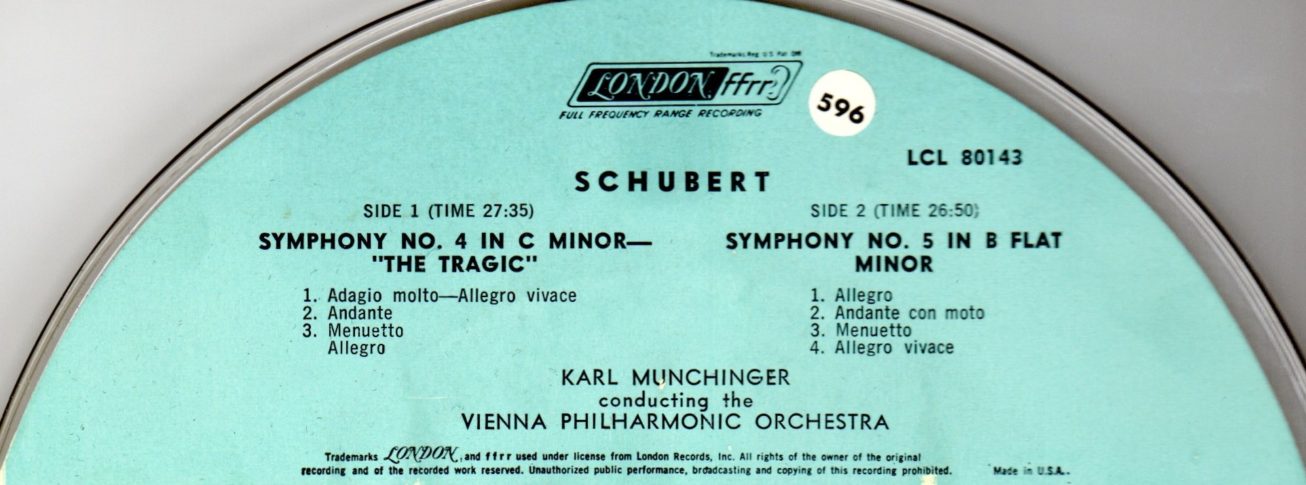
Les liens de téléchargement sont dans le premier commentaire. The download links are in the first comment.
Symphonie n°2 D.125: 13-17 mars 1959
Prod: Erik Smith Eng: James Brown
(Bande 19cm/s 4 pistes London LCL 80038)
Symphonie n°3 D.200: 22-25 février 1965
Prod: Ray Minshull Eng: Gordon Parry
(Bande 19cm/s 4 pistes London LCL 80180)
Wien Sofiensaal
________
Karl Münchinger (1915-1990) a enregistré six symphonies de Schubert avec les Wiener Philharmoniker (WPO). Son style de direction et son expérience des orchestres de chambre conviennent tout particulièrement à ce répertoire pour lequel cet orchestre est évidemment idéal.
Karl Münchinger (1915-1990) recorded six Schubert Symphonies with the Wiener Philharmoniker (WPO). His conducting style as well as his practice of chamber orchestras are especially suitable for these works, and this orchestra is of course ideal.
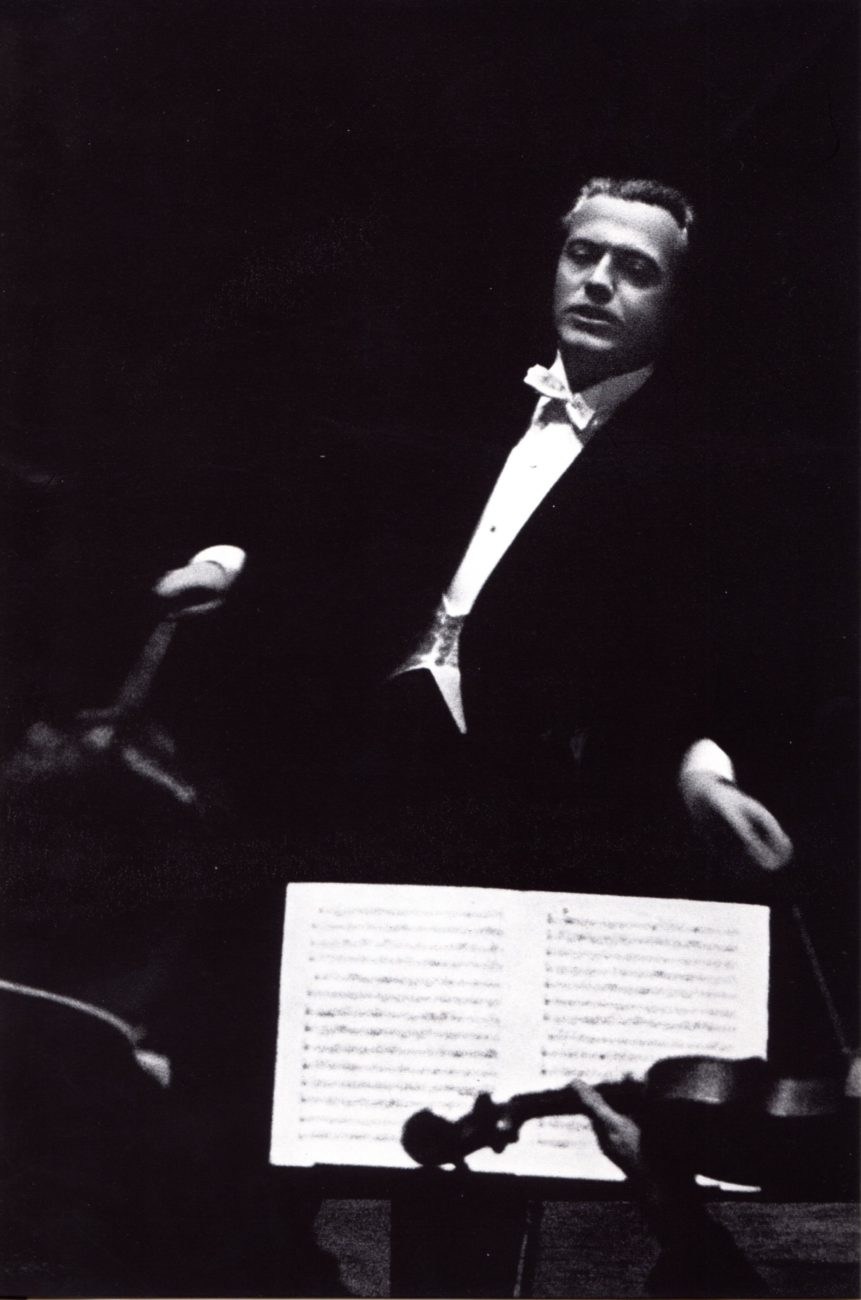
Les liens de téléchargement sont dans le premier commentaire. The download links are in the first comment.



